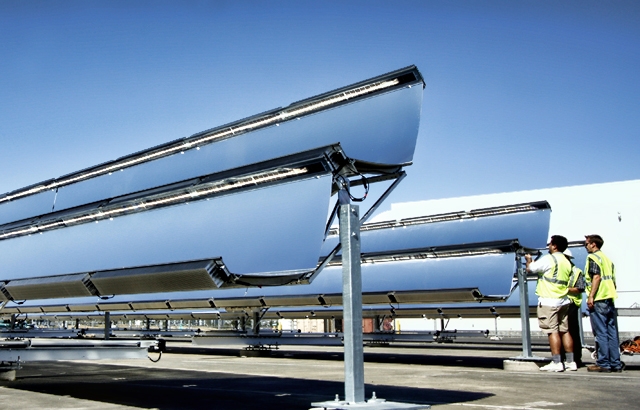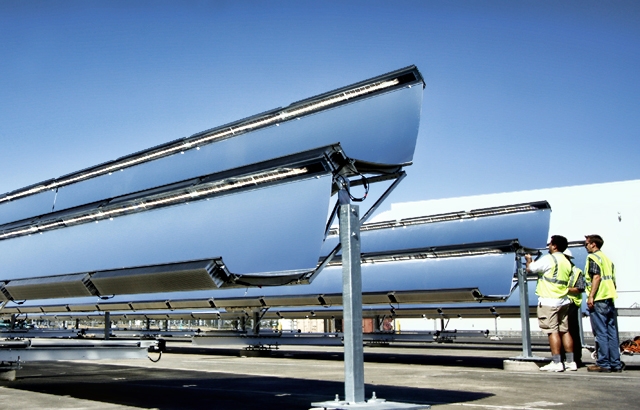 Skyline Solar is betting that its High Gain Solar technology will beat competitors on total costs and speed to market.Photo courtesy Skyline Solar
Skyline Solar is betting that its High Gain Solar technology will beat competitors on total costs and speed to market.Photo courtesy Skyline Solar
There is, it seems, always something new under the sun in Silicon Valley.
Which is why I’m standing behind a chain-link fence at the Santa Clara Valley Transportation Authority bus depot, wedged between the sprawl of tech giant Cisco Systems’ mile-long corporate campus and, incongruously enough, a mobile home park. Before me are four 120-foot-long parabolic solar troughs. They’re similar to those you’d find in the middle of the Mojave Desert at a massive solar thermal power plant where they would heat tubes of synthetic oil to create steam to drive a turbine.
But these mirrored troughs sit on a broad expanse of concrete and focus the sun’s energy on narrow arrays of photovoltaic cells attached to their sides. The concentrated sunlight boosts the solar modules’ electricity production.
This 27-kilowatt demonstration plant was built by Skyline Solar, which just last week removed the cloak of invisibility traditionally worn by stealthy Silicon Valley startups. Skyline gave Grist a sneak peak at the pint-sized power plant that feeds the bus depot’s grid before it officially takes the wraps off the project on Friday.
At a time when the global economic meltdown has thrown the solar industry into turmoil and made investors gun-shy of untried technologies, Skyline has raised $24.6 million from marquee venture capital firm New Enterprise Associates and other investors. (In a stroke of good timing, it closed the deal last September just before Lehman Brothers collapsed.) The Mountain View startup earlier this year also snagged $3 million from the U.S. Department of Energy to develop the type of concentrated photovoltaic technology it has dubbed High Gain Solar.
The promise of concentrated photovoltaic farms — so far unfulfilled — is that they can produce electricity cheaper than standard solar panels and can be built close to cities and power lines, unlike gargantuan solar thermal power plants typically located in remote deserts.
“What we’ve done here is come up with a system design that really changes the rules of the game in terms of the kinds of materials used, the cost structure and the way the systems are manufactured,” says Ben Eiref, Skyline’s director of product management, wearing sunglasses and a floppy hat in the blinding spring sunshine that has already turned the surrounding foothills golden.
These days “simple” is the new “sophisticated” in Silicon Valley, as some startups switch their focus from developing the latest whiz bang technology to making solar components as cheap and mass producible as possible.
“You need an architecture which just scales massively if solar is going to have a real impact,” says Eiref, who scouted the bus depot site while jogging on nearby running trails. “We’ve got a system that relies on a tried and true material, silicon, but we’re using very large thin metal sheets to leverage that silicon.”
The metal sheets for the troughs — “reflective racks” in Skyline-speak — can be cranked out by the thousands by any idle automotive manufacturing plant, according to Eiref. The sheets, which will be coasted with a reflective material, can then be stacked in standard shipping containers for transport.
Competitors like San Francisco’s GreenVolts and cross-town rival SolFocus — where Skyline CEO Bob MacDonald previously worked — have developed sophisticated optics that concentrate the sun as much 500 times on high-efficiency solar cells originally developed for satellites.
As Eiref points out the features of the Skyline system, the troughs — each platform holds two — slowly rotate to follow the sun, the solar arrays glowing as the light strikes the deep-blue modules. It’s relatively low tech, and the system only produces a ten-fold concentration of the sun on the solar arrays.
The tradeoff, however, is lower materials cost. Skyline is using standard photovoltaic cells cut into quarters. One technological innovation is a patented crinkled metal heat sink that backs each photovoltaic array. Solar cells get hot, naturally, and the resulting heat cuts into their efficiency.
“One of the unusual aspects of the design is that we actually flipped the cells up vertically,” Eiref says. “That allows us to put a very efficient cooling system in the back. Even a tiny bit of wind or air movement, just natural air convection, sucks all the heat out of the back of the cells.”
It’s easy to get mesmerized by all this technology — it’s as shiny and cool as a new iPhone and the future indeed looks bright on a cloudless blue-sky California day.
So to get a reality check, I ring Jenny Chase, a solar expert at market researcher New Energy Finance in London. Her skepticism comes across loud and clear about yet another claim to have cracked the low-cost solar conundrum.
“With all these solar new technologies, there are hundreds and hundreds of companies out there and if you talk to them you can be very convinced that they’re the next big thing,” she says. “The proof of a new technology now is, can they sell commercially at a price which is competitive?”
Her take: Despite all the millions that have been poured into concentrated photovoltaics, the technology has yet to prove itself in the marketplace and faces stiff competition from solar panels as the price of silicon plummets.
Eiref acknowledges that Skyline’s competition is not so much SolFocus as solar module makers and developers like SunPower and First Solar.
But it’s still early days in the nascent solar market, and the great thing about Silicon Valley is that you just never know when some company from Mountain View will have its day in the sun.
GREEN STATE: Read more of Todd Woody’s reporting on California’s green entrepreneurs.



